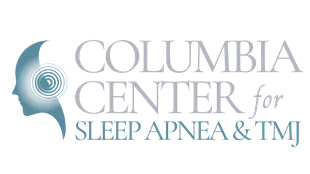Columbia Center for Sleep Apnea & TMJ
Dr. Jared Bloxham’s Journey from Chronic Pain to Innovating Patient-Centered Treatment for TMJ, Sleep Disorders, & Other Neuropathic Pain
Dr. Jared Bloxham’s practice is not a typical dental clinic. It’s not plumbed for air or water, there are no impression materials, and the chairs are not dental chairs.
Dr. Bloxham specializes in orofacial pain. He treats a variety of head and neck pain, including TMJ disorders, headaches, sleep apnea, muscle and nerve pain, and other neuropathic pain disorders. His approach is uncommon in the dental world.
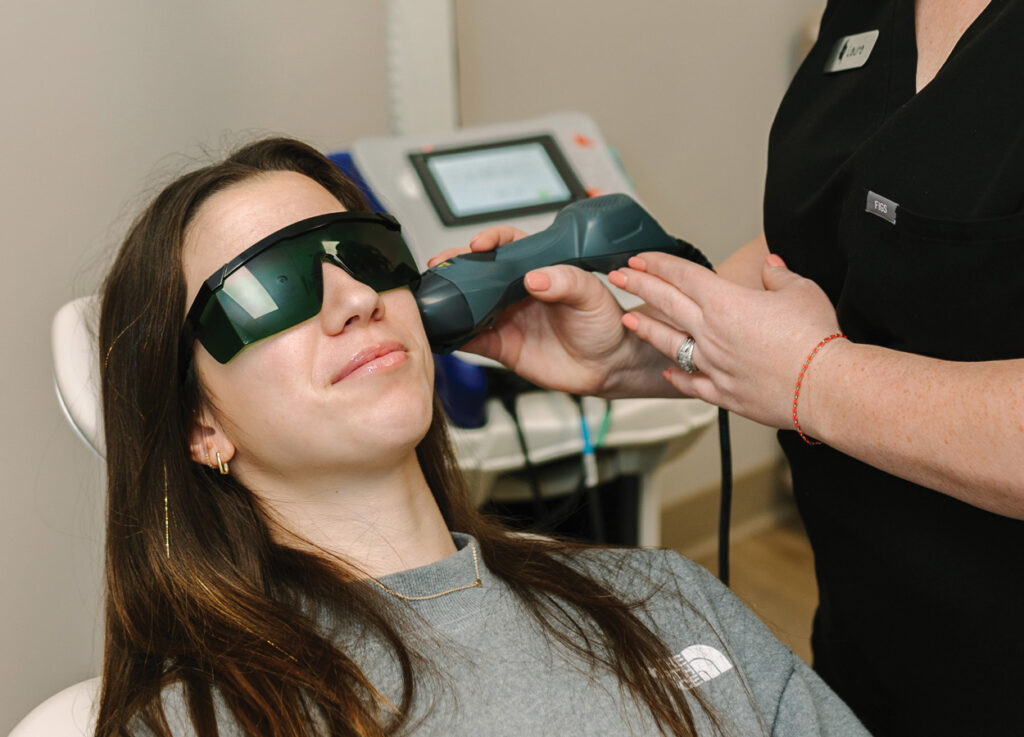
A patient receives TMJ laser therapy.
He is using his dental knowledge, his additional post-doctoral education, and his personal journey with chronic pain to improve the quality of life of his patients. His clinic’s motto is ‘We want to help you become you again.’
“We knew that we were going to have to set ourselves apart, both from a technological standpoint, and from a patient care standpoint…because if somebody’s going…to spend their hard-earned money to see us, then we better get it right…” explains Dr. Bloxham.
After years of practicing as a local dentist, Dr. Bloxham had to undergo a series of neck surgeries and fusions in 2015. He was forced to retire and sell his practice, as he could no longer perform the normal ‘drill and fill’ duties of a general dentist for hours at a time.
A year or so into his retirement, a friend approached him about some jaw issues she was having. Her dentist had done a crown, and her bite kept changing. Eventually, she was told it wasn’t her teeth moving; it was her jaw joint becoming unstable and causing issues. He admitted he didn’t have much experience with the issue, as TMJ disorders weren’t heavily covered in dental school. But retirement didn’t quite suit Dr. Bloxham; he was bored and said he would look into it.
He began with a 40-hour lecture series with Dr. Jeff Okeson from the University of Kentucky. Okeson is the Founder of the college’s Orofacial Pain Program, a renowned subject matter expert, and the author of the book “Management of Temporomandibular Disorders and Occlusion.” Originally, Dr. Bloxham’s goal was just to learn a little bit about TMD and be able to maybe give his friend some answers. And what he found was orofacial pain. He didn’t know it existed or that it was a specialty. Once he started digging deeper, he started learning about a lot of headache issues, neuropathy issues, and some of the things that he was dealing with personally, and he became extremely interested in it. And once he realized that the orofacial pain guys weren’t bent over for hours at a time and he could physically do the job, he was hooked.
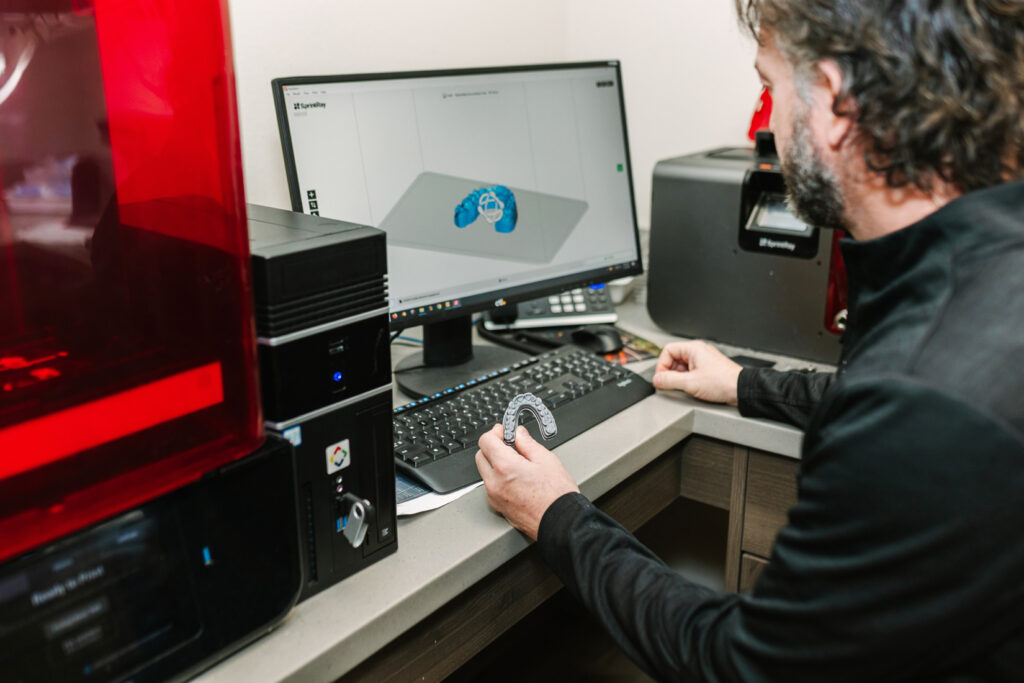
Dr. Bloxham using his SprintRay suite to design and print 3D oral appliances in-house.
“When I saw the orofacial pain program and oral medicine combined, that was kind of the missing link for a lot of providers around here. We just didn’t know where to send patients.”
He found a program designed for dentists seeking to specialize in orofacial pain at USC. He had two days before the application deadline for the next class. In a whirlwind of action, he called his old dental school and some friends, got all the letters and requirements completed within two days, had an interview, and got accepted to the program.
After receiving a master’s degree in Orofacial Pain and Oral Medicine, he was ready to open a clinic. Dr. Bloxham’s approach was to think about what he wanted his flow to be in this practice, looking heavily into the different technologies that would make him more efficient and allow his clinic to treat patients better. He spent a year of intense research and travel. He took his staff to the Indiana office of a peer he respected to learn and get an idea of what works, what doesn’t work, and what they would do differently. Then he worked with a local architect and local builder to design and build his new office.
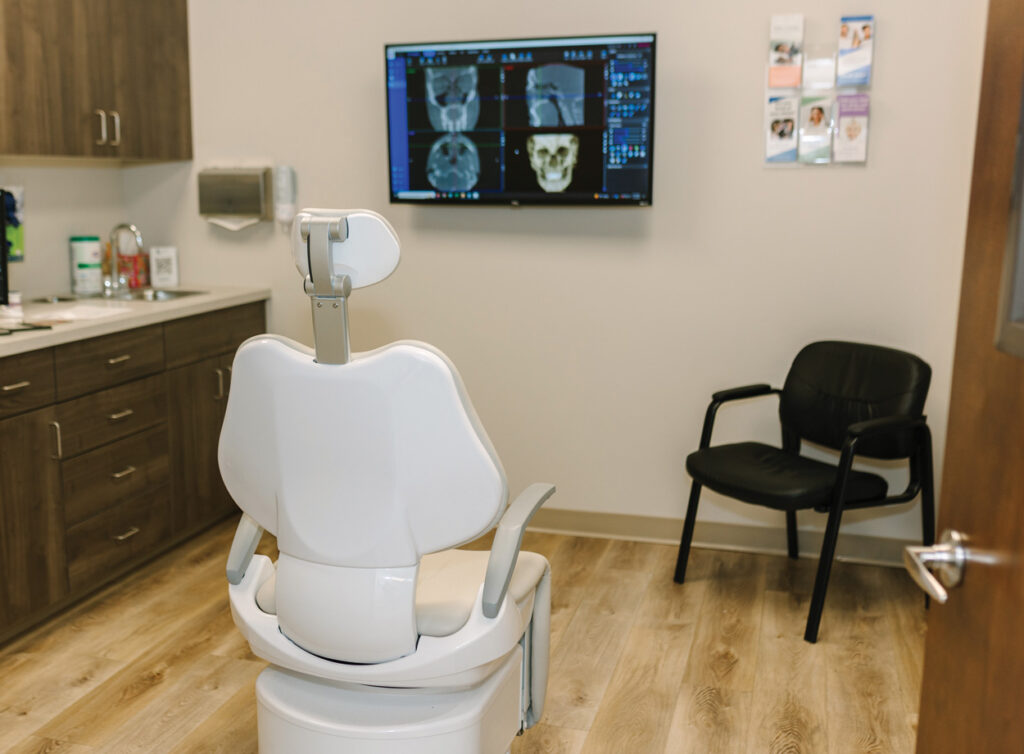
One of the operatories with a large TV for detailed consults.
When he started researching the type of equipment needed and technology, he experienced information overload and turned to Burkhart and his relationship with Burkhart Account Manager Jack Stewart.
“I learned it was like drinking from a fire hydrant, & that’s when Jack Stewart really became critical & helpful for me and the individuals that he put me in contact with.”
“I’ve known Jack for a long time, & have had a great working relationship with him for a long time…it was just really easy; he’s always been a great help.”
Dr. Bloxham knew as soon as he called him and said, “Hey, I’m looking at opening up a new practice, and here’s kind of what I have in mind,” Jack would be able to point him in the right direction and help him down that road. The result was a high-tech, functional space that allows for efficient work.
His new practice is in Richland, across town from where he was in Kennewick, still within the Tri-cities, and 15 minutes from his original practice. For Dr. Bloxham, it was an easy decision to stay because he already had a working relationship with many of the providers in the area. He knew going in that there weren’t very many of this type of specialist in the country.
The typical new patient appointment is about two hours long. Several of these patients have multiple symptoms. They often uncover dental problems, even single-tooth dental problems, that are missed on conventional X-rays.
When a patient comes in, the doctor starts with a full scan using the cone beam CT, which he describes as the diagnostic bread and butter for the practice. They use a Planmeca Viso G7 because of the large field of view it provides. This imaging must capture the trigeminal cervical complex, from about mid-neck up, all the nerves and the muscles, so most of the imaging is full field, from mid-forehead to approximately mid-neck and everything in between, looking at the entire system.
“We have a very high success rate & a very high patient satisfaction rate…maybe even more importantly, a very high referring provider satisfaction rate.”
Imaging is one of the driving forces in this practice in that, in the past, a dentist might bring an image up and show a cavity on a tooth. At this clinic, the patient will be seated, and the CT will be displayed on a TV in front of them, and the doctor will go through that CT from beginning to end. Dr. Bloxham will read the image as he goes along and talk to the patient about what he sees, and what that means based on their condition and their symptoms. He says it really drives compliance when patients understand what they have going on, whether it’s temporomandibular joint issues, sinus issues, or tooth issues. He explains that this level of patient communication has been critical for his success, that compliance rates are exponentially better because they understand and, buy into the process.
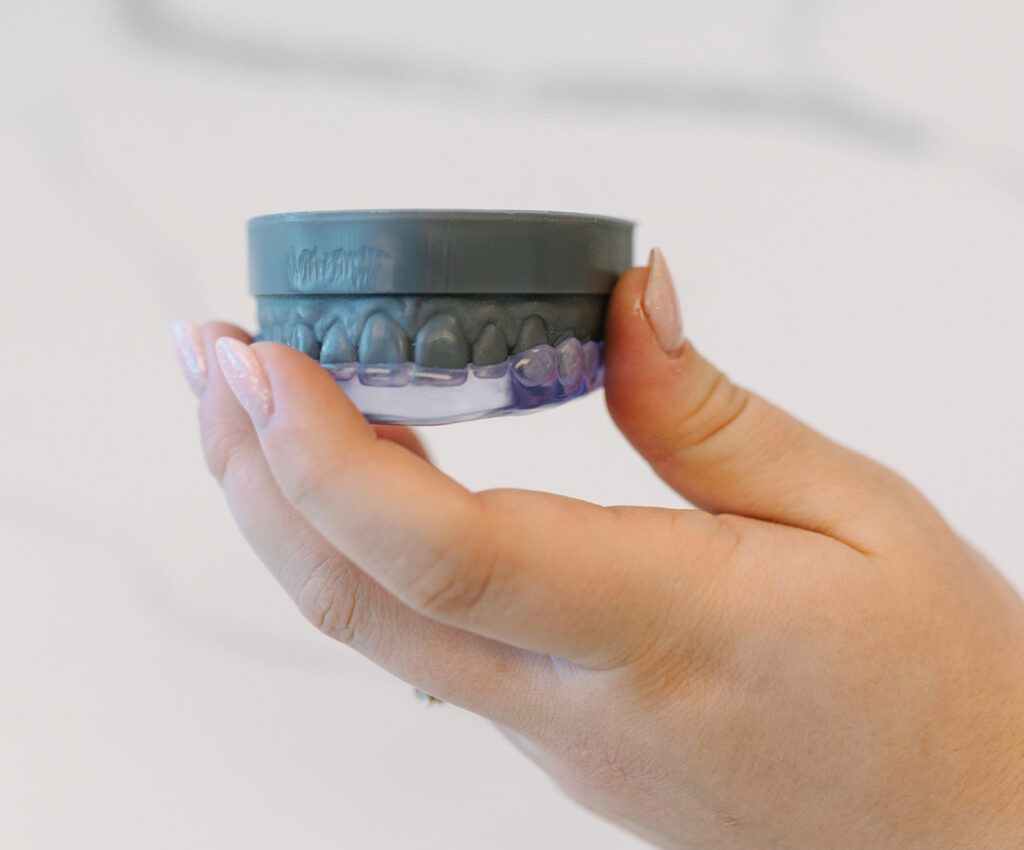
A 3D printed model and orthotic device.
They also make all their orthotics for temporomandibular disorders in-house, using the SprintRay Pro 3D equipment. Sleep appliances are sent out to the lab, and all impressions are digital. They use a Solea CO2 laser for dysplasia, precancerous lesions, oral lesions, and oral sores. It also treats erosive oral lichen planus. In addition, the practice has found the laser to be effective as an adjunct in sleep treatment for reducing snoring and vibration on the soft palate.
Sleep disorders have become a large part of the practice. This was unexpected, but due to patient demand, they started treating patients with oral appliances and started to see the positive change that it was making in these patients’ lives. They work with a lot of the sleep physicians locally. A typical patient seen at the clinic has had a sleep study in the past.
They know they have a sleep problem, and they either don’t want or can’t tolerate a CPAP. Once they are fitted with an oral appliance that can keep the airway open as efficiently as a CPAP, they will often return 6-8 weeks later well-rested and with a much more pleasant disposition. It’s become contagious for Dr. Bloxham and his staff to see the positive changes.
“I loved doing a lot of the aesthetics in dentistry, and I loved the reconstruction and hands-on artistic part. But this has been rewarding on a totally different level. We’re saving lives, changing lives, and helping people feel better and live better.”
They work with many ear, nose, and throat doctors, surgeons, and other professionals in the area who have learned what the clinic does and how they do it. Often, doctors send patients over just for imaging for suspected orofacial infections that might be missed on traditional radiography.
“It’s been really rewarding. I get phone calls almost every day from providers that have something where it’s just a simple question for their patient, and I try to make myself as available as possible, and I try to be that provider that I would want to talk to on the phone and be as helpful as I can.”
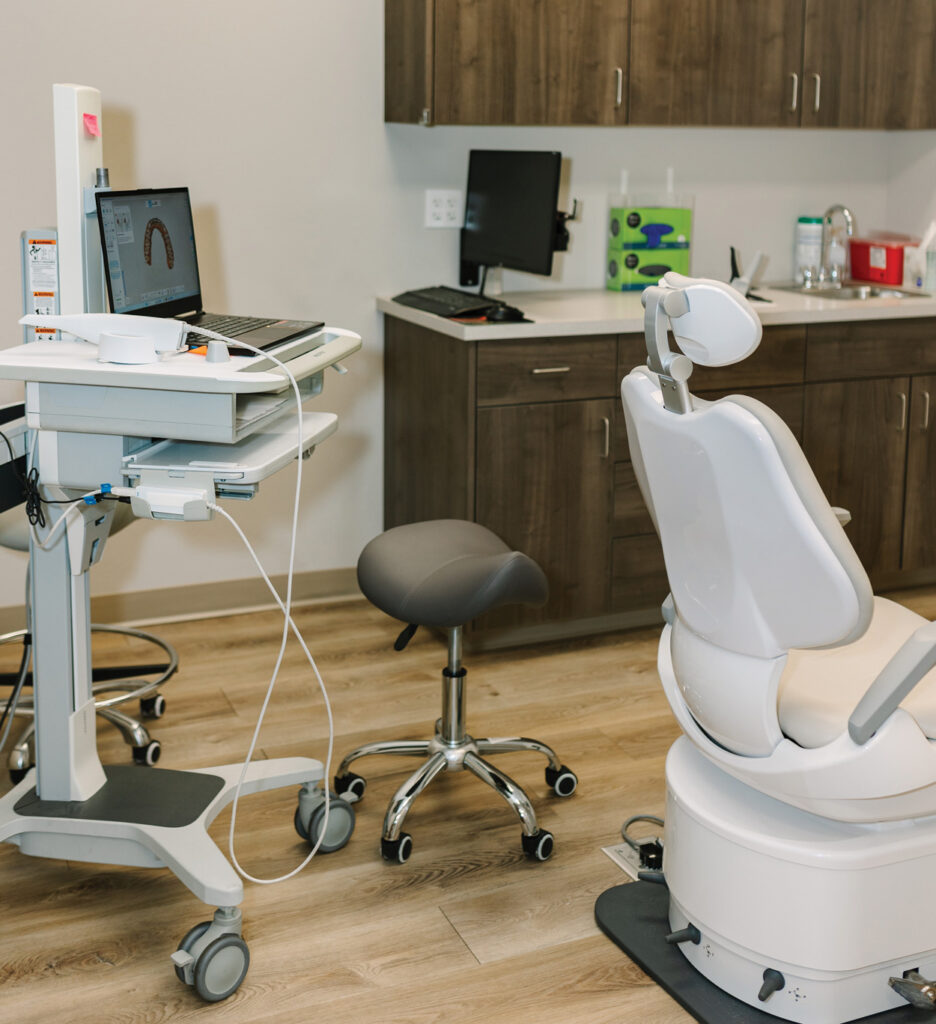
An intraoral scanner sits ready for use.
The Columbia Center is a fee-for-service practice with very limited insurance involvement. As a newer specialty, it often falls between medical and dental coverage, leaving patients caught in the middle of insurance disputes. Dr. Bloxham chose this model to avoid these delays.
“I want to treat them. I don’t want them to worry about the pre-authorizations because whenever we have somebody that tries to use their insurance program, it’s three months into it by the time we get pre-approval for their initial appointment, then for the imaging, then for any treatment,” explains Dr. Bloxham. “Instead, I can help these patients starting the same day”.
There’s been a lot of benefit to Dr. Bloxham having chronic pain himself and experiencing a lot of the same issues that his patients have.
“I think it provides me a little bit of extra measure of empathy and understanding because often patients come in, and you can’t see what they have going on. You can’t physically see that they have these issues; it’s just something that they have to feel and deal with daily. So people don’t understand what you’re going through, and it’s some of the most painful conditions that humans are aware of.”
Dr. Bloxham was not expecting this work to be as emotionally and psychologically rewarding as he has found it. He describes an atmosphere where he and his staff get equally excited by the changes they see in the patients and what they are able to accomplish at the clinic. And he is thankful to all those who have helped get his practice to where it is today.
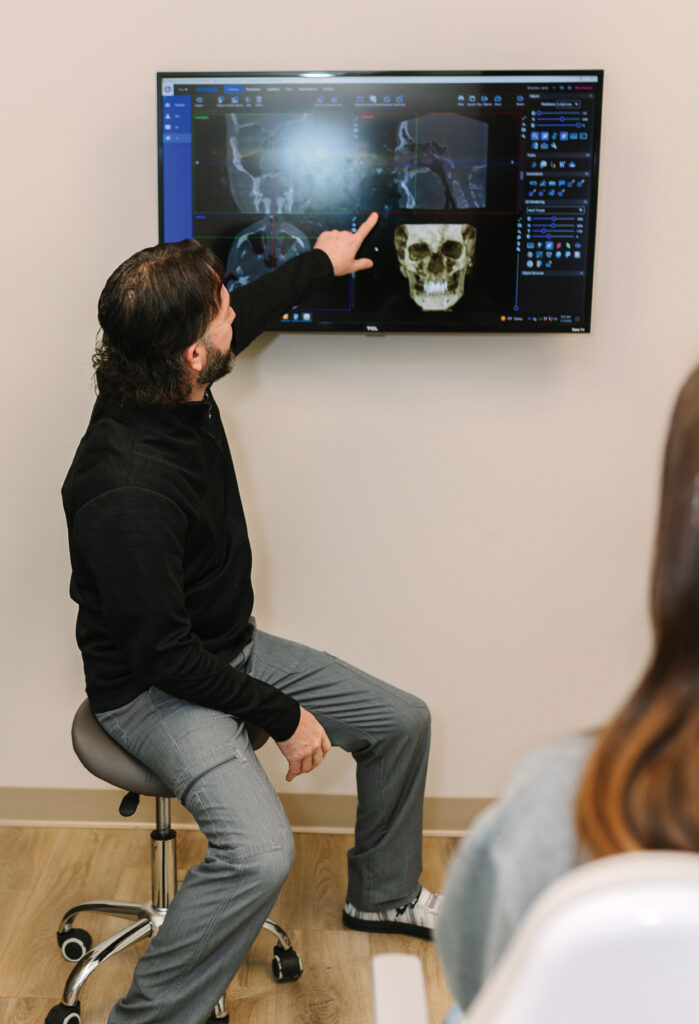
Dr. Bloxham reviewing CT images in detail with a patient.
“I’m at the point now where I can look back, and I have an immense amount of pride for what we’ve done, and I know that I am not alone in that Burkhart played a big part… My family played a huge part…patients have played a huge part in that they’re referring. Providers have played a huge part in that.”
In summing up his success, Dr. Bloxham boils it down to his core principle, which reflects his experience, his motto, and his approach in general:
“All we’ve done, really, is just try to treat people like we’d want to be treated if we walk through the door. And I think that has come across…that’s made us successful.”
What is Orofacial Pain?
In 2020, Orofacial Pain was recognized as a dental specialty. The National Commission on Recognition of Dental Specialties and Certifying Board granted the request, making it the 12th ADA-recognized dental specialty.
The American Academy of Orofacial Pain (AAOP), founded in 1975, is a professional membership organization representing the specialty of orofacial pain. It is an organization of dentists and other health professionals dedicated to alleviating pain and suffering through the promotion of excellence in education, research, and patient care in the field of orofacial pain and associated disorders.
“Orofacial Pain is the specialty of dentistry that encompasses the diagnosis, management, and treatment of pain disorders of the jaw, mouth, face, head, and neck. The specialty of Orofacial Pain is dedicated to the evidence-based understanding of the underlying pathophysiology, etiology, prevention, and treatment of these disorders and improving access to interdisciplinary patient care. (Adopted September 2020)” writes the National Commission on Recognition of Dental Specialties and Certifying Boards, American Dental Association.
Learn more about Orofacial pain.
Learn more about Dr. Bloxham’s Columbia Center for Sleep Apnea & TMJ
Written by Dawn Kahl.
Published in Catalyst – Q4 2025.
Category: Technology
Back to Articles